Your tomatoes aren’t perfect like these of mine? Your plants don’t still have vivid green foliage in late summer? Mine do. You are failing.
This is the message that some gardeners receive. This summer, I’ve heard from a number of first-time gardeners who feel like failures because their tomato plants don’t look perfect, like those shown in blogs and videos.
Those tomatoes are phony, I tell them. The tomatoes I photographed above are phony.
I harvested around twenty tomatoes this morning, and then I selected the three prettiest from my basket. I held them next to the tomato plants in my garden that have the greenest foliage and I snapped a picture. It’s a phony photo in that it does not represent what is actually happening throughout my garden.
I visit many other gardens and have done so for many years. None of them have had tomato plants that were all perfectly successful.
You are not alone. Everyone growing tomatoes has mixed success.
Here are some tomato failures that can be seen in my yard today:
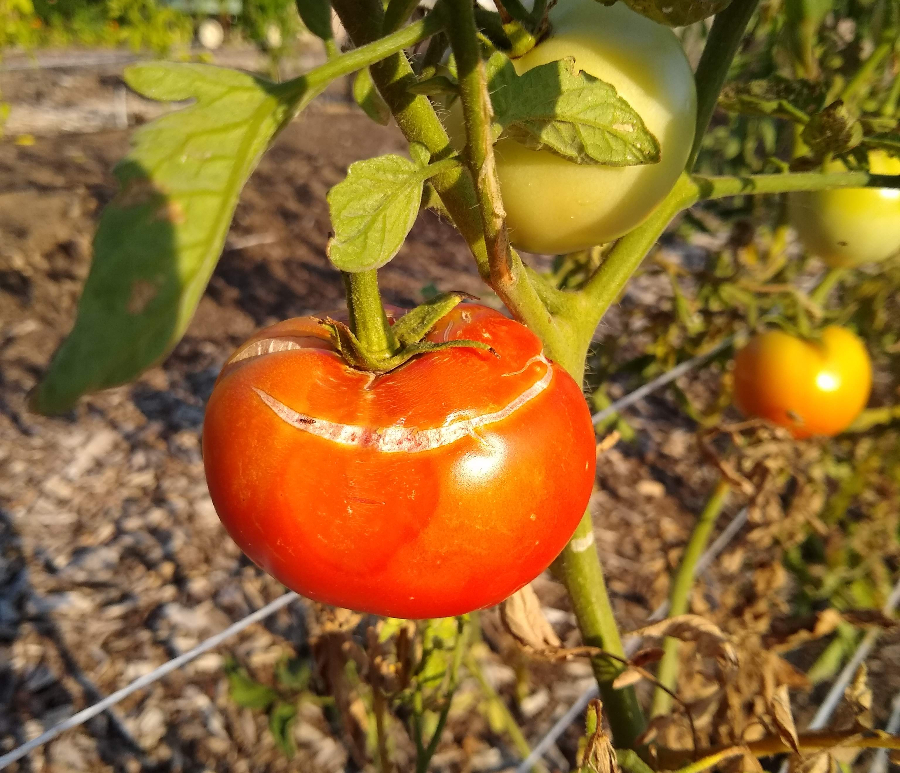
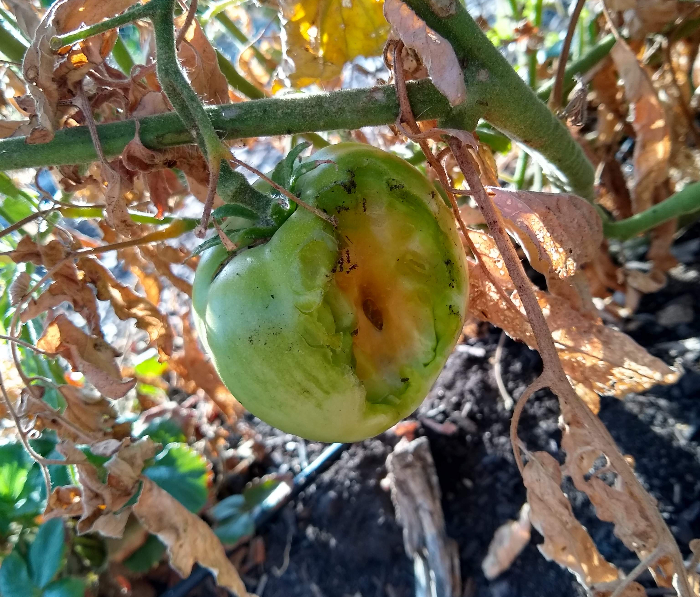

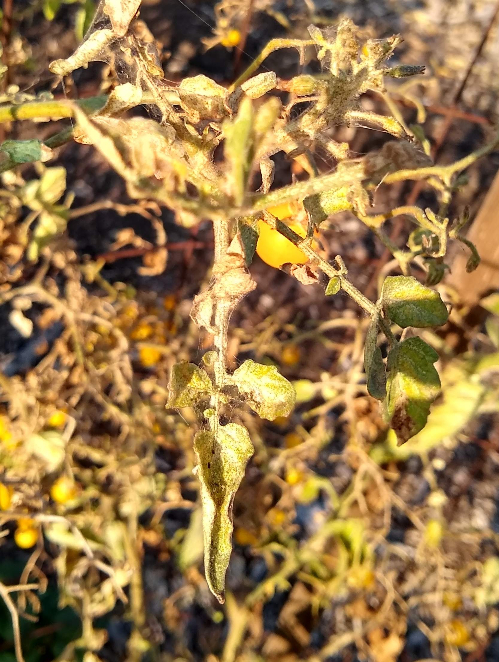
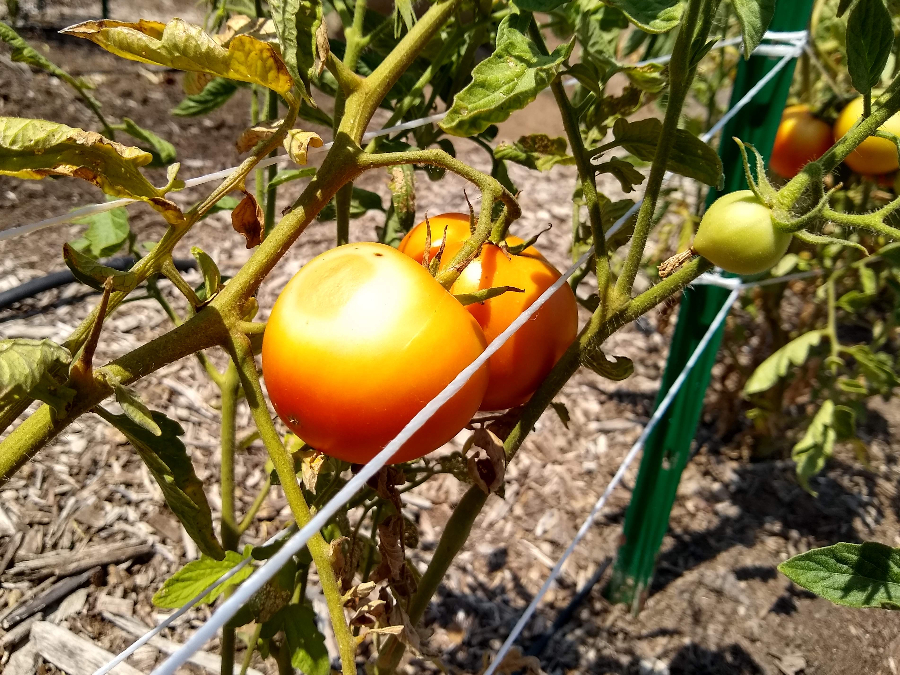
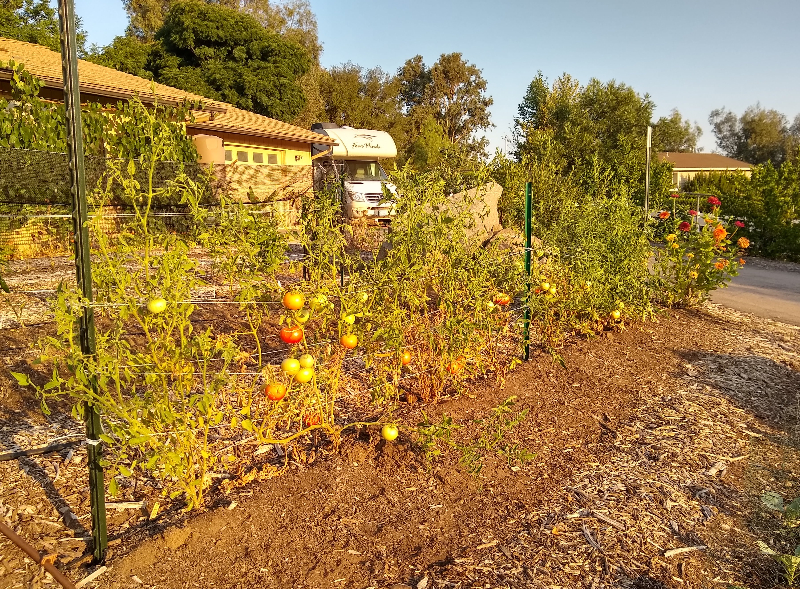
The sparse foliage of those plants doesn’t protect the fruit from the sun. The sparse foliage sparse is due to root knot nematodes in the soil. (“What are root knot nematodes?”)
On the other end of the spectrum, I have a tomato plant in another row that has beautiful, dense plant growth but not a single fruit. What’s the good of all those leaves?
Here are a couple of problems that I’ve seen in other gardens this summer:
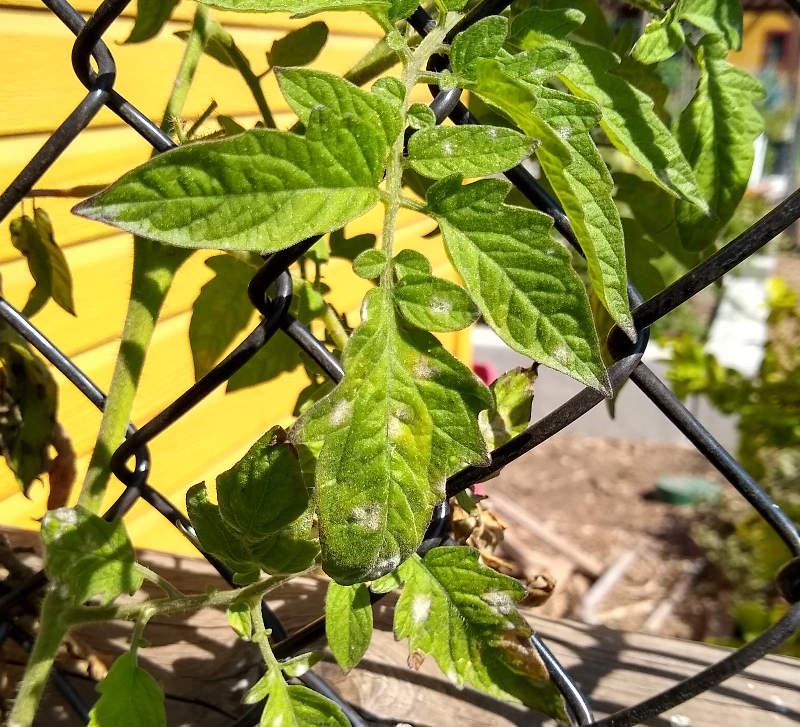
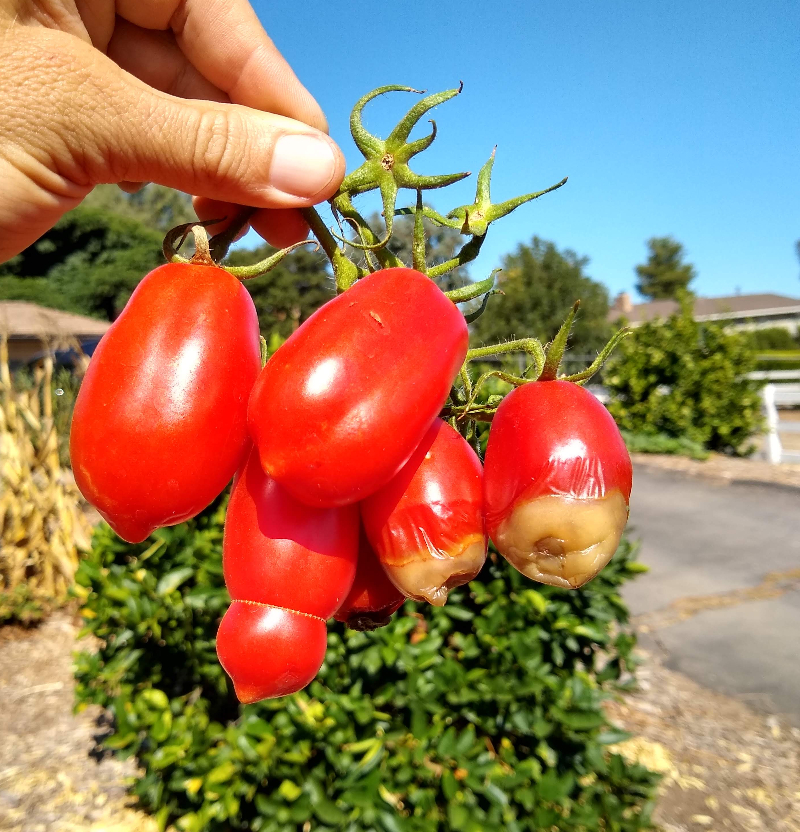
This photo was taken in my own yard a couple years back. I’ve had years with lots of this “blossom end rot”, but this year I’ve had almost none. I have also had powdery mildew on my tomato plants in the past, but I’ve had none this summer. The photo of it above was taken at someone else’s garden near the beach, where powdery mildew is more prevalent compared to my inland location.
Keep this in mind: Every year, your failings will be slightly different and the amount will fluctuate too.
So we can’t expect perfection. I hope you feel better knowing that there’s a lot of imperfection among my tomato plants right now.
Going forward, just because we can’t expect perfection doesn’t mean we shouldn’t try to minimize the failings. Next week’s post: “Succeeding at Tomatoes.” I’ll share the best methods I know for dealing with ways that tomatoes can go wrong.
All of my Yard Posts are listed HERE

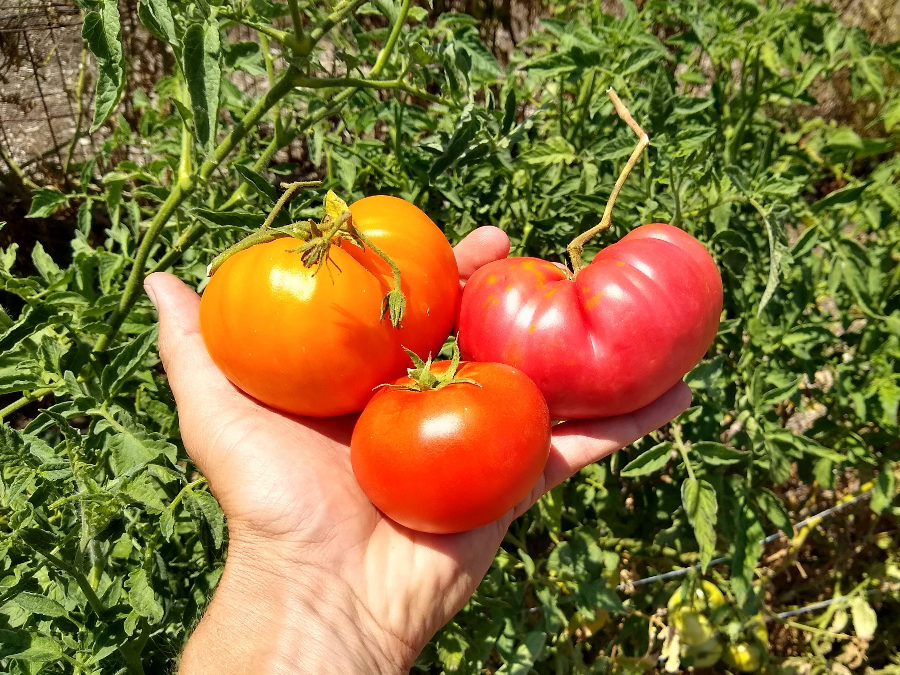


Thank you for this. My neighbor is blessed with an abundance of perfect tomatoes. My first go at it was more or less a running disaster, crowned by discovering a trio of those ghastly hornworms on my plants the other day. Argh! Looking forward to advice for doing better next year.
Thanks so much! This info was very helpful.
It never fails, very soon after the summer solstice, most everything in the garden takes a definite downturn including tomatoes.
Yes, Axel. Why is that? I’ve never been able to find a satisfactory explanation. My only guess is that the soil gets drier and drier as we get farther from the rains of winter. (And along with this, the salt content increases as we apply more and more irrigation.)
I love that you are sharing this message! Some years we have success and others not so much. Every failure is a learning experience. We can’t control nature but should take joy in the times that we are good partners.
The spidder mites get worse every year. This year they were so bad I didn’t get a single tomato.
Why does every gardener work so hard for the perfect tomato? The plants are water guzzlers. Every part of the plant gets eaten by some critter. They need lots of supplements. At the end of each season, I decide no tomatoes next year. And yet, I plant them anyway. Tomatoes are planted in October where I live. I’m getting my seed trays cleaned up and ready to plant!
2 years ago I purchased a 6 pack of better boy plants. I planted 4 up on my hillside where there is lots of sun in soil that is rich and super enhanced. I planted one from the six pack in a spot next to my deck. That one plant had produced tomatoes with no tomato end rot. All the tomatoes on the hillside had end rot. I thought it was mold, but my reading taught me it was a lack of calcium, So last year I loaded the soil with bone meal and gypsum – also added a couple bags of steer manure. Dug it all in and let it age during our rainy season. Planted 4 better boy plants this year and they grew nice and green and looked healthy. When the first flowers opened I used an electric tooth brush to vibrate them to pollinate. To my amazement, my tomatoes again had end rot, but not as severe. I’ve been using Sevin and therefore there has been only a small loss from rodents, worms, and fig beetles. I hate using insecticides, but the bugs have been ruining all my fruit probably due to their free rein for years increasing their numbers each year. It is August 14, 2021 and my plants still look pretty good and a new crop of tomatoes are days away from harvest. I suggest those people with problems, plant several plants in different soil and locations and see which ones do best – that will be your new growing area.
Thanks a lot for taking the time to write this, Rick.
Your garden usually will do better if you rotate your crops so the same insects don’t build up.
Hi Greg: A timely article as my tomatoes are a horrid disappointment this year. Many have a wilt where the smaller branches just die after the leaves initially start to curl. Any ideas? I am bottom watering early in the morning.
Also this is the first year I’ve used pre-purchased “gopher mesh” cages (flimsy material about 2 gal size) that the tomato’s were planted inside. Have you ever heard of problems when using these? I plan to do a plant autopsy and pull one up and investigate the root structure. Thanks again, any response Greg.
Hi Joseph,
Check out information on verticillium wilt: https://www2.ipm.ucanr.edu/agriculture/tomato/verticillium-wilt/
And fusarium wilt: https://www2.ipm.ucanr.edu/agriculture/tomato/fusarium-wilt/
I’ve never heard of a problem with tomatoes caused by gopher baskets.
It’s comforting to know that I’m not the only one with temperamental tomatoes. The problems vary from year to year but overall, they are one of the most rewarding things in the garden. I haven’t used pesticides in years and am finding that the birds and other predators are keeping up with things as long as the plants remain healthy. This time of year, in the inland valley, everything except the winter squash is giving up; but I’m ready for a break from the constant watering and harvesting anyway. That said, my neighbors never tire of my heirloom tomatoes though they’ve had enough of my summer squash.
Keeping up with the Joneses? Wears you out and you can end up quitting prematurely
Gardening is tough for me here having grown up in the Midwest. Definitely learning. Appreciate your posts. Thank you.
Thank you for this post Greg, and all of your others! Very interesting and REAL!
Thank you for this post. I have been trying to grow tomatoes for several years despite the fact that my family aren’t big tomato eaters. And every year I seem to have problems. I’m actually thinking of giving up on tomatoes and focusing on veggies that will have a better success rate. I feel less frustrated knowing it isn’t just me!
I had blight destroy my tomatoes this year (two plants, Black Krim and Wild cherry). I did however get pounds of tomatoes from the Black Krim before it gave up. Also, my summer squashes, cucumbers, and cantaloupes all got destroyed by powdery mildew. I do not spray in my garden. I also crop rotate. Some times it doesn’t work out. And instagram is so fake.
Hi Dan,
From the gardens I’ve seen this summer in various parts of Southern California, powdery mildew has been a little worse and more widespread than I remember in the recent past.
I grow my vegetables in 6′ tall 1/2″ galvanized wire mesh cages with swing doors that we built many years ago, so no vermin problems except mice and a small rattle snake that got in this year. Two years ago, I had root knot nematodes & a terribly large amount of mites, so I waited until this year to plant tomatoes again. In NW Ramona, I was given & planted 2 Early Girl (not much flavor but produced many fruit, still picking them), 3 Brandy Wine (fewer fruit, but huge–bigger than my palm, and delicious, tall plants, still picking), & 4 cherries that sprouted up themselves last Nov. and produced sweet fruit this year. One cherry has mites, dropped all its leaves but still has tasty fruit on it; 4 worms were found & squashed, endless grasshoppers caught with a slow hand (they won’t jump away) & squashed little by little so no adults formed. I used home compost, blood & bone meal, bought manure, and fish emulsion. None of the plants are dark green any more but the fruit still looks great. I don’t use pesticides or herbicides. Hand watered early every morning, used wire cages for support. No powdery mildew, lots of wind on my slope. I’ve been growing Amaranth to eat the foliage and it’s been growing gang busters! I keep cutting it and it keeps regrowing. It’s from the same plant family as spinach (and tastes much like spinach when cooked) which I’ve had no luck growing. I’m also growing watercress, kale, achicoria, arugula & different bok chois, usually grown in the winter…from all that daily irrigation! The tomatillos self seeded & are loving the heat. All in all, if I hadn’t had my summer break from work, I would have struggled trying to keep everything alive.
Hi Linda,
I’m always looking for new summer greens to eat. I haven’t tried amaranth in a long time. Are you growing a specific variety that you can recommend? Sounds like you are keeping busy!
My neighbor and I live on 4 acres collectively. All are heavily mulched. The birds planted the best cherry tomatoes! We have so many plants that it is impossible to pick daily and keep up.
The secret: no water, no fertilizer, no nothing. A few vines are trellised, most are not.
I consider myself relatively a relatively successful tomato grower. I have had all the problems you cite and more. My latest foray into gardening is only a few years old – the biggest issue I had when I made my most recent start a few years ago was loss of almost ripe fruit to birds and rats before I could pick them. All of my plants now are behind “hardware cloth” (1/2 grid of wire mesh.) This year’s bane was spider mites. Initially I thought it was a disease until the Armstrong lady clued me in. I found that cherry tomatoes, especially “volunteers” were the most susceptible, but the mites (like the rats and the hornworms and the birds) are relentless, and short of burning you fields, the best you can hope for is to keep knocking them down so they don’t kill the plants. I found that spraying with a fairly powerful garden hose TWICE a day, reduces their numbers. You’ve got to handle the plant to get under the leaves, too. Removing the leaves that are most infested also slows them down. Insecticide won’t kill them. Soaps won’t kill them. Oils won’t kill them. Ladybugs might eat a few, but millions will be hatching while they dine. There are supposedly specific mite predators you could buy but they are wicked expensive. And probably no more effective than the hose. (PS. mites also like to eat potato leaves.)
Despite all the tribulations, and my relatively small plots (I had maybe eight producing tomato plants this summer) I probably harvested at least 250 regular tomatoes and 500 cherrys. (Gave a lot away.) I still have plants producing and I am trying some Stupice to see if they will grow through December (not hopeful, they looked near dead after a 44 degree night. They come back during the day, but I don’t know if they’ll make it as the days get shorter and cooler.) The thing is, tomatoes are ~$2 a pound. It’s one of the few plants you can buy that will produce more produce than you could just buy at the grocery. Armstrong centers sells a 4″ romaine for $5. You can buy a 10″ fully grown lettuce for $1.50 at Ralphs! Home Depot sells Broccoli seedlings for $4. Again, you can buy a fully grown head of broccoli, ready to eat, for less. There were times this summer when I could count well over 100 tomatoes in various stages on my eight plants. I’m not saying it is economical or more sustainable than a farm, but it’s less ridiculous than broccoli.
Thanks for all the great info, Greg! Still hoping and wishing for an avocado from my backyard.
Hi Alan,
I’ve got a couple tomato plants succumbing to spider mites right now. Since it’s so late in the year, I’m just going to let them decline. It’s affirming to hear that the only thing that’s worked for you has also been frequent blasting with water. I just have a tough time staying consistent with it though.
You’re so right about the economic advantage of growing tomatoes at home. I’d never thought about that. I’d always just thought about the taste advantage.
But you reminded me of a post I wrote back in 2015 about the economics of homegrown broccoli. The prices in the post are a bit out of date now. (Has there really been that much inflation since 2015?!). It’s still interesting to read: https://gregalder.com/yardposts/the-economics-of-homegrown-broccoli/
My potted tomato plant has a number of yellowing leaves and few small green fruit left. What can/should I do to try to encourage it through the end of it’s season? And then what?
I had that green thing happen one time – the healthiest, bushiest greenest plant. Not a speck of mildew! And ZERO tomatoes.